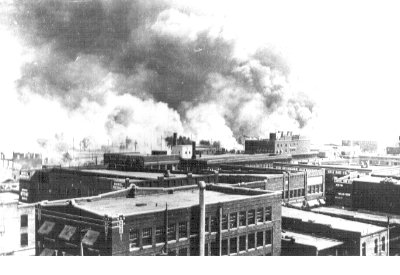The fatal shooting of an unarmed black man in Tulsa, Oklahoma on September 30th and the resultant community reaction triggered a historical flashback for me. There are many events that get forgotten in the shadows of history, many of them intentionally. This is one such event (I just read about it a few years ago), and it happened in 1921 in Tulsa. After World War I, a particular section of Tulsa was thriving. It was the Greenwood District, and it was African-American. In fact it was known as the “Black Wall Street”. But all that suddenly changed.
On May 30, a black man was accused of assaulting a white elevator operator. Rumors began to spread throughout town, and soon there was a full-fledged riot on May 31 – June 1. Martial law was declared, and the Greenwood District was pretty much decimated.
Details vary. According to the Tulsa Historical Society and Museum (http://tulsahistory.org/learn/online-exhibits/the-tulsa-race-riot/),
“In the early morning hours of June 1, 1921, Black Tulsa was looted and burned by white rioters. Governor Robertson declared martial law, and National Guard troops arrived in Tulsa. Guardsmen assisted firemen in putting out fires, took imprisoned blacks out of the hands of vigilantes and imprisoned all black Tulsans not already interned. Over 6,000 people were held at the Convention Hall and the Fairgrounds, some for as long as eight days.
Twenty-four hours after the violence erupted, it ceased. In the wake of the violence, 35 city blocks lay in charred ruins, over 800 people were treated for injuries and contemporary reports of deaths began a t 36. In 2001, the Tulsa Race Riot Commission released a report indicating that historians now believe close to 300 people died in the riot.”
t 36. In 2001, the Tulsa Race Riot Commission released a report indicating that historians now believe close to 300 people died in the riot.”
The Wikipedia account (https://en.wikipedia.org/wiki/Tulsa_race_riot ) is more lurid, describing at least a dozen airplanes dropping burning balls of turpentine on rooftops, but there were no fire alarms. Eighty years later, the state-appointed Tulsa Race Riot Commission concluded that the city had conspired with the mob.
Have you ever heard of this? Probably not, because it’s rarely mentioned in history books. So when an unarmed black man is shot by police, there may be more in people’s minds than one confrontation.
The photo is from the Tulsa Historical Society and Museum website.
